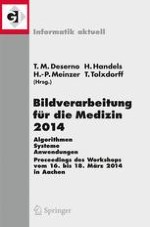In den letzten Jahren hat sich der Workshop "Bildverarbeitung für die Medizin" durch erfolgreiche Veranstaltungen etabliert. Ziel ist auch 2014 wieder die Darstellung aktueller Forschungsergebnisse und die Vertiefung der Gespräche zwischen Wissenschaftlern, Industrie und Anwendern. Die Beiträge dieses Bandes - einige davon in englischer Sprache - umfassen alle Bereiche der medizinischen Bildverarbeitung, insbesondere Bildgebung und -akquisition, Molekulare Bildgebung, Visualisierung und Animation, Bildsegmentierung und -fusion, Anatomische Atlanten, Zeitreihenanalysen, Biomechanische Modellierung, Klinische Anwendung computerunterstützter Systeme, Validierung und Qualitätssicherung u.v.m.
